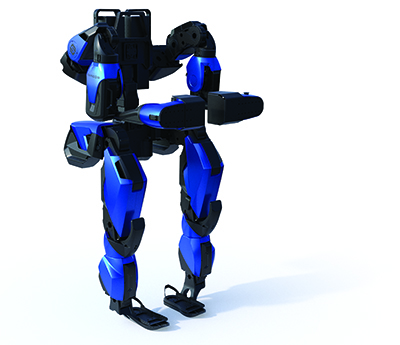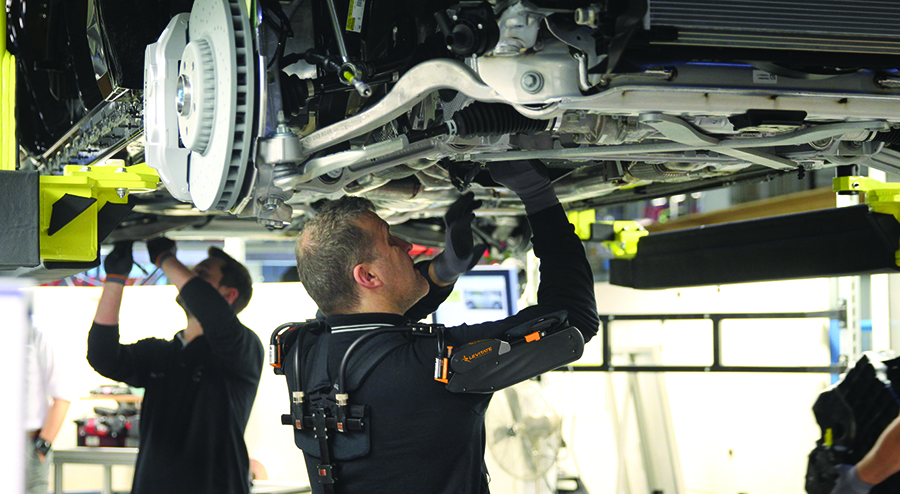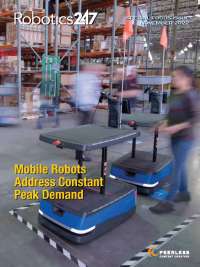If your only connection to the exoskeleton is Tony Stark and Iron Man, you may think of a technology that gives you the strength to safely lift and move heavy items over and over again as the stuff of comic books and Hollywood. But exoskeletons are coming to market to protect warehouse and manufacturing workers from bad backs, shoulders and neck injuries related to heavy and repetitive lifting. They provide a lift to muscles, literally, with the idea of letting the worker hardly feel the strain as the machine takes on a significant portion of the weight.
Make no mistake, exoskeletons are an emerging technology, one developed for the military. But some corporations are testing and deploying exoskeletons. Last November, for instance, StrongArm Technologies reported that some 30 customers were using or testing its system, including Walmart and Toyota.
 “Exoskeletons have the power to change everything because your workforce is everything,” says Ignacio Galiana, CEO of Verve, a technology company in the alpha phase for exoskeletons. “People doing lifting are vital. From a financial standpoint, it’s key for a company but also for caring about workers. They deserve to go home to the people in their lives and be healthy—whether it’s their first day or they’re starting the first day of their 20th year with the company.”
“Exoskeletons have the power to change everything because your workforce is everything,” says Ignacio Galiana, CEO of Verve, a technology company in the alpha phase for exoskeletons. “People doing lifting are vital. From a financial standpoint, it’s key for a company but also for caring about workers. They deserve to go home to the people in their lives and be healthy—whether it’s their first day or they’re starting the first day of their 20th year with the company.”
Kristi Martindale, chief customer officer and executive vice president of product strategy for Sarcos Robotics, offers that these injuries are hurting everyone, from workers to companies. A labor shortage in the manufacturing, warehousing and logistics industry is creating a productivity gap for companies globally. Specific to logistics and warehousing, they experience a 25% to 50% annual turnover, and an estimated 50% to 70% of the warehousing budget is attributed to labor costs, she says. Added to that, each back injury from a workers comp claim is around $40,000 to $80,000.
“When you look at the lost opportunities, the loss of wages, the cost of the medical treatment, it adds up to about a $100-billion problem per year in the United States,” Martindale says.
The exoskeleton could slice these costs down to size, but what even is an exoskeleton? Consider it a mechanical extension of an operator, often wearable and used for assistance in a range of motion. It is often used as an aid to walking, for example. It can be battery-powered or not; using a small motor or other lift assist technology, it can support muscles used for lifting, providing a push that may avoid pushing a worker’s body past its limits.
Hard vs. soft
There are two types of exoskeletons: hard and soft. Hard exoskeletons have a rigid interface and include a solid frame and rigid structures. Soft devices tend to be lighter weight, but still use a lift assist technology.
Verve’s exoskeleton, for instance, is a soft device, with an operator experience that is similar to wearing clothing. “It can be worn every day, yet any time you lift something, it will feel about 30% lighter,” says Galiana, who was part of a team that began work on the exoskeleton technology research at the Wyss Institute for Biologically Inspired Engineering at Harvard University. Verve is now looking toward commercializing the product. “Our system is technically composed of textiles and has a small motor for power that is similar to motors used in consumer robot applications. The system acts like an external muscle that applies force to your biological muscles and has integrated sensors to adjust to your movements.”
Why choose soft? “We looked at how muscles were working and then joints,” Galiana says. “When moving joints, it felt like probably there would be restrictions to movement unless you had a pretty complicated mechanical design. Here, you can move completely free. When you need it, the power is there. When you don’t, it’s out of your way so you can focus on your work.”
When an operator lifts an object, the exoskeleton also applies assistance to the back and the hips. “Remember, the No. 1 cause for disability in the world is back pain,” Galiana says. “We hope to put a stop to this kind of pain that can be excruciating.”
In some applications, a hard exoskeleton may be more appropriate. Levitate Technology’s exoskeleton, for example, is designed to help hold up people’s arms to prevent fatigued shoulders, necks and backs. “It originated from our experience in the operating room with surgeons and medical device surgical instrumentation,” says Joseph Zawaideh, vice president of marketing and research development and co-founder of the company. The device features a rigid hard frame worn to transfer the load to the outside of the hips. With straps and a belt, it weighs just more than 5 pounds and has cassettes instead of motors that are right outside the arm attached to the armrests. Mechanically powered with a series of cables, pulleys and strings, it offers the attractiveness of not using a power source.
In an industrial setting, the devices provides assist in applications that involve holding your arms above your shoulders for extended periods. Think of the strain you feel when you’re reaching up to change a light bulb overhead, Zawaideh says. Now, imagine that you’re changing 20 to 40 bulbs, back to back, at shoulder level or right above your head. “If someone standing next to you puts their hand right above your elbow right as you raise your arm and give a shove to your arm, you would say ‘ahh, thank you’ and all that aching goes away—and, then, as you lower your arm to grab the next light bulb, they get their hand out of the way,” he says.
Levitate’s exoskeleton technology is already lending a hand in industries such as aerospace and automotive. For the latter, Levitate piloted its technology with Toyota, which saw the considerable amount it was spending on injuries due to overhead activity actually go down to zero in 2018 and 2019, he says. Toyota later went to deployment.

Powering the suit
Sarcos Robotics has a long history of kinematics in the form of robots patterned on human behavior. In fact, a full body powered exoskeleton suit developed by Sarcos was named 2010 Innovation of the Year by Time Magazine. However, the hydraulically powered suit required 6800 watts to operate; the current design significantly reduces the amount of power required to operate and is more realistic for an industrial setting.
The current version, still in the alpha stage, is a hard battery-powered industrial exoskeleton model (named the Guardian XO) that uses only around 400 watts of power during normal operation as an industrial product, according to Martindale. The motors augment the user’s lifting capabilities to offer a 200-pound lift capacity, beyond the clutches, actuators and software used to manage the exoskeleton. Martindale offers that an advantage of going with Sarcos’ exoskeleton is the ease of use and the advanced control system, which allows the operator to feel a portion of weight for context, which, she says, lowers the chances of flinging large items across the room by losing control. The strength applications are usually set to a 20-to-1 percentage of lifting weight, taking a great deal of the weight off the worker.
The exoskeleton is stored in a standing position at a docking station used for software updates and battery recharging. To put it to work, operators slip their feet into the bottom of the suit and put their arms into a harness. Clamp the front, and it’s ready to go. “All in, an experienced operator has the capability of getting in and out of the suit in about 30 seconds,” she says.
The operator provides the directional input to the exoskeleton though their movement, and in response, the sensors throughout the suit stay equidistant away, helping the suit to constantly get out of the person’s way as it moves with the operator. When it comes to grabbing and manipulating an item, end-effectors act as the exoskeleton’s hands. An end-effector, Martindale says, can possibly be one that can be adjusted or where you have many kinds to choose from.
The company’s goal is to have the exoskeleton commercially available later this year. The cost would be based on a one-to-three-year lease and will range from approximately $100,000 to $150,000 annually, she says.
Ready for prime time?
Exoskeletons were on display at Modex 2020 in Atlanta this past March. There’s little question that industrial employers are looking for solutions that will make repetitive tasks, like lifting and overhead installations less stressful and more interesting. That’s both to cut down on turnover as well as the cost of back, shoulder and neck injuries. At the same time, whether the time is right for the technology is still an open question, notes Bryan Jensen, managing partner of the design and consulting firm St. Onge. “If you’d asked me that question in February, I would’ve given you a very different answer than now,” Jensen says. “We don’t know whether we’ll still be experience labor challenges and high turnover with a high unemployment rate.”
Still, we know what too many workers are saying now, as they grab at their aching bodies. Robert Downey Jr. comparisons aside, industrial workers aren’t Tony Stark billionaires, but people with a potentially stark reality when it comes to short-term and long-term injury. “Iron Man comparisons may be a small part of what gets a worker interested,” Galiana says. “But what will really grab them is a better quality of life. They want to get out of bed, ready to see their co-workers and give their best effort. We’re hopeful that this will make them look forward even more to going to work. …These workers help everything move.”
Companies mentioned in this article:
Article topics
Email Sign Up


















